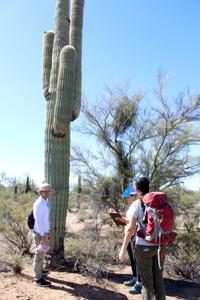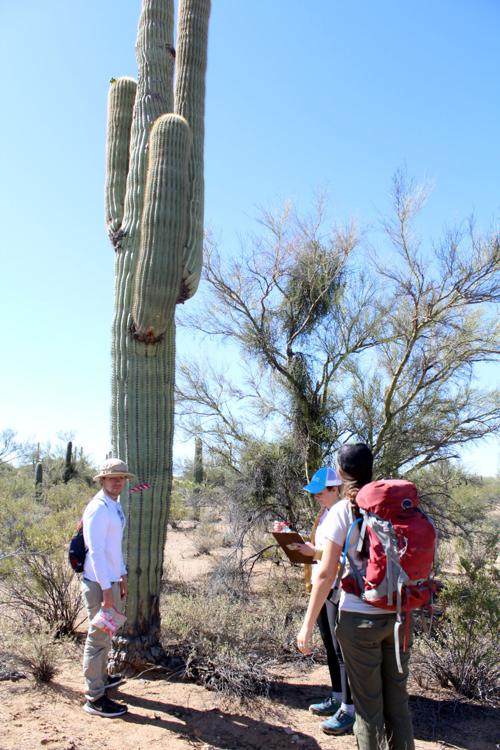Public participation in gathering and analyzing large amounts of scientific data began as a major trend about 15 years ago in a movement called “citizen science.”
When asked if scientists could produce this same work without the help of citizen scientists, the general refrain was typically “absolutely not.”
The internet and the availability of powerful, yet simple tools such as a smartphones, created conditions in which almost anyone can participate in scientific research in ways that were impossible just a few years ago.
“Like many good ideas it takes a while to germinate and, all of a sudden, it has exploded,” said Joaquin Ruiz, dean of the University of Arizona College of Science, talking about ordinary citizens gathering data for scientific research.
The fruit of citizen science work is often used to publish papers in scientific journals.
Funding goes a long way when there are citizen scientists volunteering their time, said Don Swann, a biologist at Saguaro National Park and coordinator for the Saguaro Census. “At the same time, we can get high quality data with the proper amount of training.”
It’s also an educational tool. “If done properly, it adds to our understanding of the particular disciplines,” Ruiz said. “So all of a sudden, the people trying to get an education become scientists themselves.”
As an added benefit, citizen scientists might also find a passion in the work they are participating in and become an advocate for it, Swann said.
If you are curious about a subject and want to participate in a citizen science program in the Tucson area, here are some local projects:
Science and saguaros
Every 10 years, volunteers are trained to count and record features of saguaros in 45 permanently studied, 200-meter-square plots dotting Saguaro National Park.
“The survey is where we assess the health of saguaros in the park,” Swann said. “It’s a huge project.”
Data collection on saguaros began not long after the park was established in 1933.
The last census was hosted in 2010 and included more than 300 volunteers. Another 300 participated in the 2016 Centennial Saguaro Survey to celebrate 100 years of national parks.
The next census will be held in the winter of 2019-2020.
Swann frequently fields inquiries from people who want the opportunity to volunteer.
School groups, like Tucson High Magnet School in 2015, are also welcome to participate.
In one case, Swann enlisted a canyoneering club to help with plots that were more difficult to navigate.
Besides the scientific value from the data, Swann noticed that exposure to the parks and the species they encompass can generate concern for conservation.
“Part of our job is to protect these plants that mean so much for Southern Arizona. This survey was created to study and protect the saguaros, so this feeds directly into our conservation strategies,” Swann said.
Gila monster paparazzi
Swann partnered with Kevin Bonine, director of education and outreach at Biosphere 2 to address two main objectives: learn more about Gila monsters and promote interest in the species and natural habitat.
Bonine runs a program in which hikers in and around Saguaro National Park can submit photos of Gila monsters that they might stumble upon.
Adult Gila monsters have a pattern of pink or orange and black scales “like a fingerprint,” Bonine said. “It doesn’t change.”
“People can go out and when they see a Gila monster, take a photo of it and record the date and location,” Swann said. There are many ways to submit: using the iNaturalist app, sending via email or bringing it to the visitor center.
Matching patterns to identify individuals and recording their locations allows researchers to track how long they live, their home range, when they’re most active and how their behavior might change over seasons or years, Swann said.
Time’s ticking
Phenologists study the timing of seasonal events, such as when saguaros bloom, insects hatch or birds migrate.
The timing of certain biological events could shift as a result of climate change.
“There are consequences to this,” said Theresa Crimmins, assistant director of the National Phenology Network. “The biggest is that not all species respond in the same way and at the same time (to climate change)...we see phenological mismatches emerge.”
The NPN is headquartered on the UA campus and hosts various citizen science opportunities for a range of skill levels.
Since its 2009 launch, almost 11,000 people from across the country have submitted 12 million data points that have resulted in 40 peer reviewed science publications, Crimmins said.
Curiosity takes flight
The Tucson Audubon Society also runs multiple citizen science projects and volunteer opportunities for a range of skill levels, said Jennie MacFarland, bird conservation biologist and Tucson Bird Count Coordinator.
During Christmas bird counts, each individual bird and species within a 15-mile diameter circle plot is recorded by bundled bird watchers using binoculars.
“Christmas bird counts are fun and great because they utilize those high skill levels as well as beginning birders,” she said.
The Tucson Audubon Society just wrapped activities celebrating the year of the hummingbird, but other programs include the Arizona Important Bird Areas Program and the Tucson bird count.
“Citizen scientists have contributed huge amounts — two databases that have 100,000 data lines of bird sightings,” MarFarland said.
The Tucson bird count is suitable for more experienced birders.
Tucson is home to hundreds of birders, MacFarland said. “Southeastern Arizona is terrific for birding. It’s one of the top three (birding hotspots) in the nation. People will retire here to live out their passion.”





